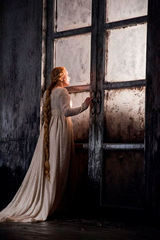| Opera Reviews | 28 April 2024 |
An intriguing Pelléas et Mélisande by Scottish Operaby Catriona Graham |
|
| Debussy: Pelléas et Mélisande Scottish Opera March 2017 |
|
|
Debussy excised some explanatory scenes from the original play, so much is unknown, hinted at. It appears that, following the death of his wife, Prince Golaud goes off on a mid-life gap year, during which he meets a strange, young woman. About six months later, having married her, he brings her home to Allemonde, where his grandfather Arkel is king – and as good as blind. Golaud’s father is seriously ill – off-stage throughout the opera – and his half-brother Pelléas wants to leave. Oh, and there is famine in the land. Sir David McVicar wisely eschews an ethereal, quasi-medieval setting in favour of the Belle Époque. Anne Mason’s Geneviève is a substantial matron wearing copious strings of pearls and a pearl brooch at the throat. Carolyn Sampson’s Mélisande may be a bit fazed when Golaud first meets her, but she is definitely flesh and blood. So many questions - why does Geneviève throw her son Pelléas and Mélisande together? True, they make a lovely couple and their voices blend well, but it is asking for trouble and clear-voiced Andrei Bondarenko is just impetuous enough as Pelléas. Why does Arkel foretell a bad outcome? Alastair Miles is excellent as the old king, and the warmth of his care and affection for Mélisande, particularly on her death-bed, is vivid in his voice. Is it symbolic that Mélisande is evidently pregnant just when King Arkel announces that the unseen father – and presumably his son – is recovering at last, as spring comes round? By then, of course, Roland Wood’s Golaud is far gone in jealousy. The claustrophobic atmosphere in the castle is enhanced by Paule Constable’s lighting and Jack Henry James’ projections; the darting doves in the scene where Mélisande lets down her hair Rapunzel-like for Pelléas; the eerie, shimmering light in the cave where Golaud sends Mélisande to retrieve the ring he gave her – why, when he, Golaud, plainly does not believe her story? Rae Smith’s uncluttered design – tall French doors down one side of the stage matched by tree trunks (stalactites / stalagmites) on the other – echoes the space in the music and in the story while enforcing the closeness of the forest to the castle. A nice point is the framing of the scenes by the raising and lowering of the black curtain in a square shape, turning the scenes into vignettes, especially at the cave. The orchestra plays with verve for conductor Stuart Stratford although, at times, from where this reviewer sat, the balance was not in the singers’ favour. Thomas John, however, as Golaud’s young son Yniold, easily holds his own, and is convincingly discomfited by his father’s interrogations and rages. This production is intriguing enough to spend time mulling over its riches, not least Mélisande’s death-bed – with Golaud standing in exactly the same place and pose as he was when the curtain rose three hours before.
|
|
| Text ©
Catriona Graham Photo © Richard Campbell |

 ‘In my end is my beginning’ more or less sums up Scottish Opera’s production of Pelléas et Mélisande, Debussy’s opera on Maeterlinck’s Symbolist play.
‘In my end is my beginning’ more or less sums up Scottish Opera’s production of Pelléas et Mélisande, Debussy’s opera on Maeterlinck’s Symbolist play.






